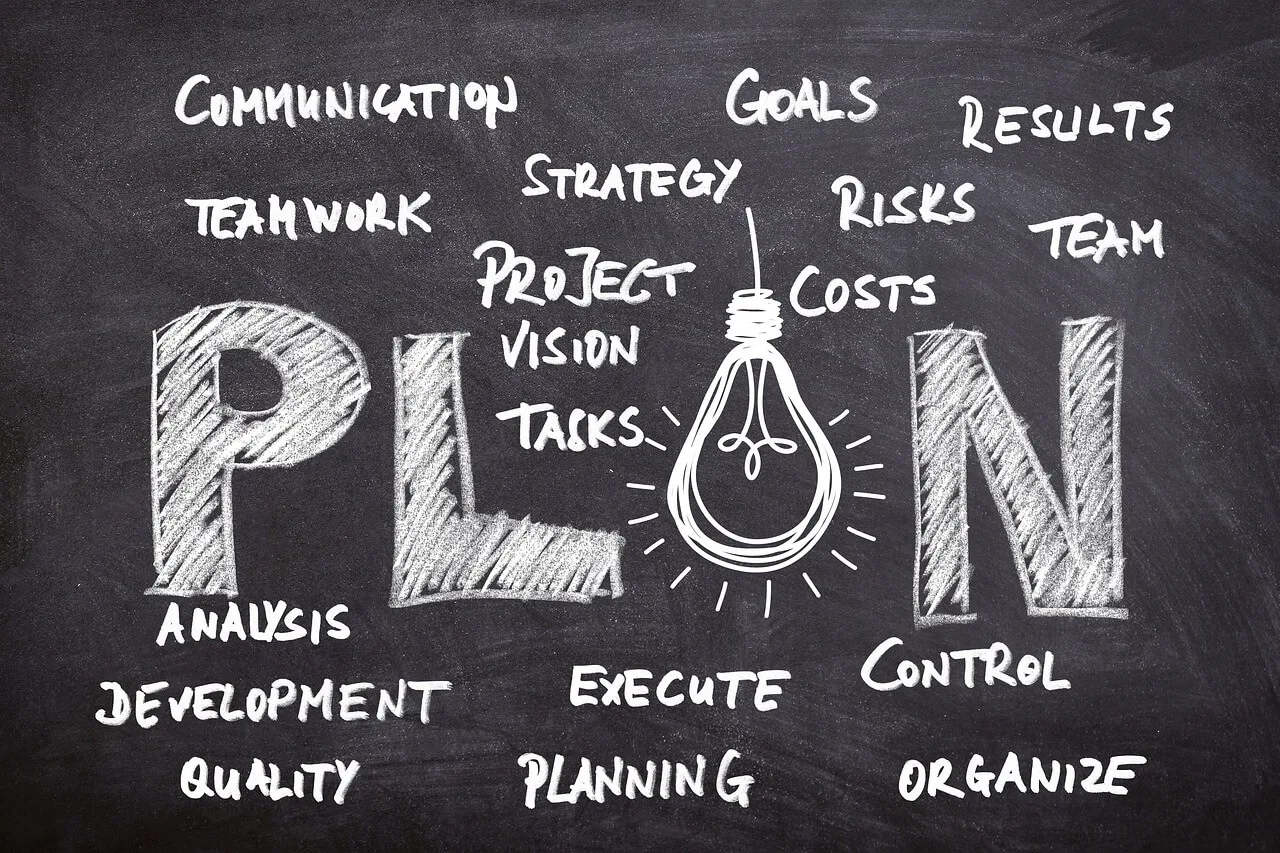Creating a Business Plan Preparatory Steps and Analysis to Achieve Project Goals
A project business plan is a detailed document that outlines the goals, strategies, and plans necessary for the execution and management of a specific project. This document includes market analysis, identification of required resources, determination of organizational and financial structure, marketing and production plans, risk management strategies, and a timeline for activities and tasks. The business plan is a fundamental tool to ensure the success of the project and the achievement of its defined objectives.
1- Setting Objectives and Vision
Setting the project's objectives and vision involves clearly defining what the project aims to achieve and the overarching purpose behind it. This includes identifying specific, measurable, achievable, relevant, and time-bound (SMART) goals, as well as articulating the broader vision or mission that the project aligns with. Having a clear understanding of the project's objectives and vision provides a guiding framework for decision-making and resource allocation throughout the project lifecycle.
2- Market Analysis and Target Audience
Market analysis and identifying the target audience involve researching and understanding the market dynamics, including trends, competition, and potential opportunities and threats. This analysis also entails identifying the characteristics and preferences of the target audience, such as demographics, behaviors, and needs. By conducting a thorough market analysis and understanding the target audience, businesses can tailor their products or services to better meet customer demands and gain a competitive edge in the market.
3- Determining Required Resources
Determining the required resources for the project involves identifying all the assets, both tangible and intangible, needed to successfully execute the project. This includes human resources (such as skilled personnel and expertise), financial resources (such as funding and budgets), physical resources (such as equipment and facilities), and informational resources (such as data and technology). By accurately assessing and allocating the necessary resources, the project can be effectively managed and executed within the constraints of time, budget, and scope.
4- Developing a Marketing Plan
Developing a marketing plan involves outlining the strategies and tactics that will be used to promote the project's products or services to the target audience. This includes conducting market research to understand customer needs and preferences, defining the project's unique selling propositions, identifying marketing channels and platforms (such as advertising, social media, and content marketing), setting specific marketing objectives and goals, establishing a budget, and creating a timeline for implementation. A well-developed marketing plan helps ensure that the project reaches its target audience effectively and efficiently, ultimately driving sales and achieving business objectives.
5- Defining Organizational and Administrative Structure
Determining the organizational and administrative structure of the project involves defining the roles, responsibilities, and reporting relationships within the project team. This includes establishing a hierarchy of authority, specifying lines of communication and decision-making, and allocating resources and tasks to team members. Additionally, it involves setting up mechanisms for monitoring and evaluating project progress, resolving conflicts, and ensuring effective coordination among team members. A clear and well-defined organizational and administrative structure helps streamline project operations, improve communication, and enhance overall efficiency and effectiveness.
6- Creating an Operational and Production Plan
Developing an operational and production plan involves detailing the processes and procedures necessary to carry out the project's activities and deliver its products or services. This includes defining the workflow, scheduling tasks and activities, allocating resources, establishing quality control measures, and setting performance metrics. Additionally, it involves identifying potential bottlenecks or challenges in the production process and developing contingency plans to address them. A comprehensive operational and production plan ensures that the project is executed smoothly and efficiently, meeting quality standards and fulfilling customer requirements within the specified timeframe and budget.
7- Risk Assessment and Mitigation Strategies
Risk assessment involves identifying potential threats or uncertainties that could impact the project's objectives, schedule, budget, or quality. This includes analyzing both internal and external factors that may pose risks, such as market fluctuations, technical challenges, resource constraints, and regulatory changes. Once risks are identified, strategies can be developed to mitigate or manage them effectively. These strategies may include risk avoidance, risk reduction, risk transfer, or risk acceptance, depending on the nature and severity of the risk. Regular monitoring and review of risks throughout the project lifecycle are essential to ensure timely response and minimize their impact on project outcomes.
8- Financial Planning and Funding
Developing a financing plan involves determining the financial requirements of the project and identifying sources of funding to meet those needs. This includes estimating the costs associated with project implementation, such as equipment, materials, labor, and overhead expenses.
Once the financial requirements are established, potential sources of funding can be explored, such as:
1. Equity financing: Obtaining funds by selling shares of ownership in the project to investors.
2. Debt financing: Borrowing funds from banks, financial institutions, or private lenders,h wich must be repaid with interest.
3. Grants and subsidies: Securing financial assistance from government agencies, non-profit organizations, or other entities that provide funding for specific projects or initiatives.
4. Crowdfunding: Raising capital through online platforms by soliciting small contributions from a large number of individuals.
5. Self-financing: Using personal savings or assets to finance the project.
Once funding sources are identified, a financial plan can be developed, outlining how funds will be allocated, managed, and utilized throughout the project lifecycle. This plan should include budget projections, cash flow forecasts, and contingency plans to address any financial risks or challenges that may arise. Regular monitoring and review of financial performance are essential to ensure that the project remains within budget and achieves its financial objectives.
9- Implementation and Monitoring Plan
Developing an execution and monitoring plan involves outlining the specific steps and activities required to implement the project successfully, as well as establishing mechanisms for tracking progress and performance. Here are key steps to develop such a plan:
1. Define tasks and activities: Break down the project into smaller tasks and activities, assigning responsibilities to team members and setting deadlines for completion.
2. Create a timeline: Develop a detailed timeline or schedule outlining when each task or activity will be executed, taking into account dependencies and critical path analysis.
3. Allocate resources:Ensure that resources, including human resources, materials, and equipment, are allocated effectively to support project activities.
4. Establish monitoring mechanisms: Define key performance indicators (KPIs) and metrics to measure progress and track performance throughout the project lifecycle.
5. Implement communication protocols: Establish regular communication channels and protocols to facilitate collaboration and information sharing among team members, stakeholders, and project managers.
6. Identify and manage risks: Continuously assess potential risks and develop strategies to mitigate them, ensuring that the project remains on track and within scope.
7. Review and adjust:Regularly review progress against the plan, identifying any deviations or issues, and make necessary adjustments to ensure that the project stays on course to achieve its objectives.
By developing a comprehensive execution and monitoring plan, project managers can effectively manage resources, track progress, and address any challenges or issues that may arise, ultimately increasing the likelihood of project success.
10- Continuous Evaluation and Improvement
Continuous evaluation and improvement involve systematically assessing the project's performance and processes, identifying areas for enhancement, and implementing changes to optimize outcomes. Here's how to incorporate continuous evaluation and improvement into project management:
1. Regular assessments: Conduct periodic evaluations of project progress, performance, and outcomes against predefined metrics and objectives.
2. Feedback mechanisms: Solicit feedback from stakeholders, team members, and customers to identify strengths, weaknesses, and areas for improvement.
3. Root cause analysis: Investigate the underlying causes of any issues or deviations from the plan to address systemic problems and prevent recurrence.
4. Benchmarking:Compare project performance against industry standards or best practices to identify opportunities for improvement.
5. Iterative adjustments: Make incremental changes to project plans, processes, and strategies based on evaluation findings to enhance efficiency and effectiveness.
6. Training and development: Invest in training and development programs to build team skills and capabilities, addressing any gaps identified through evaluation.
7. Documentation and knowledge management: Document lessons learned and best practices from project experiences to inform future projects and promote organizational learning.
By embracing a culture of continuous evaluation and improvement, project teams can adapt to changing circumstances, overcome challenges, and achieve increasingly better results over time.
In conclusion, developing a comprehensive business plan for the project is essential for achieving success. This plan helps guide efforts, organize resources effectively, reduce risks, and increase chances of success. By setting objectives, analyzing the market, determining resources, and developing executable plans with monitoring and evaluation strategies, the project can successfully achieve its goals and desired outcomes. Through continuous evaluation and improvement, the project can adapt to changes and thrive in the long run.





